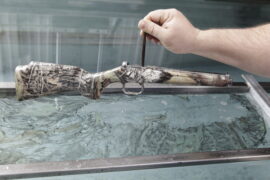
Metal Finishes: Bluing, Electroplating, and Spray-Coats
Weather isn’t always kind to steel: rust never sleeps. For the first six centuries of its existence, guns also had to deal with corrosive residues, first from black powder residue forming sulphuric acid, then from salts from mercury-based primers. First gun finish was bluing, a form of carefully controlled surface oxidation. The technology already existed for plate armor, used both to reduce corrosion and to provide a dark background for decorative gold and silver inlay. Bluing didn’t become mainstream until the second half of the 19th century.
Bluing
Rust bluing is done exposing parts of the firearm to surface oxidation by solutions of nitric or hydrochloric acid to create stronger, less chemically active finish than the usual ferrous oxide rust that threatens unprotected iron or steel surfaces. The resulting colors range from brown to deep blue or black. Browning is done with the same chemicals but with hot water immersion.
Sometimes, heat is contraindicated, so more labor-intensive fume bluing is done for a similar effect. Blued surfaces must remain oiled to avoid further oxidation. Due to the toxic nature of the solutions, proper ventilation is particularly important.
Currently, hot bluing is more common: steel is immersed into a boiling point solution of potassium nitrate and sodium hydroxide. More rust-resistant than other bluing methods, it’s also a quicker process, therefore the default method for commercial firearms. Not necessarily pretty, this result is quite practical.
Cold bluing is also a modern process but used mainly for touch-up. Brushed up on wear points, it creates a thin film or copper selenide or similar, a finish that isn’t as good against rust or mechanical wear as the others but much better than bare metal. While easy to apply, this method can cause subsurface rust: the guidelines must be followed closely for a successful result.
A couple of effects are more decorative in intent. The first is nitre bluing done with potassium or sodium nitrate salt bath immersion. Due to the high temperatures involved, around 600*F, this process isn’t for anything that retains heat-treating but yields a range of colors from gold to blue to black, depending on the time the parts spend in the solution.
Color case hardening is developed from surface hardening once used to improve soft steel for receivers. A time- and energy-consuming process, it has been adapted to include leather along with bone and wood charcoal. As the multi-hour heating in the crucible ends, the metal is dropped into aerated water or oil, producing a variety of swirly color patterns. These two methods combined are favored by bespoke gun makers like Turnbull.
Electroplating
Nickel electroplating was the earliest non-bluing process to gain wide popularity after 1870s. Depending on the quality of the process, the coatings have either flaked off or stayed remarkably intact. The gun parts, usually the frame and the cylinder of a revolver, acted as a cathode inside an electrolyte solution, while nickel or an alloy thereof became the anode.
Under current, nickel ions were transferred to the steel parts as plating. This finish was in much demand in humid environments, remaining popular until stainless steel and more durable finishes for carbon steel became available.
Nickel boron plating is done without electricity. A major advantage of this method, besides outstanding corrosion resistance, is increased surface lubricity. The micro-bump texture of nickel boron reduces surface friction, reducing interference between mating surfaces. It also holds oil well, making this finish an excellent choice for guns subject to high volumes of fire.
Gunkote and Cerakote
Gunkote and Cerakote are competing ceramic spray-coats. Both offer excellent rust and scratch protection, lubricant retention, and heat dissipation. Cerakote requires a high-temperature bake, Gunkote does not but dries much longer at ambient temperature. Gunkote is usually slightly slicker to the touch, Cerakote is more abrasion-resistant, but the finishes are otherwise quite similar.
Both can be applied to materials other than metal. Cerakote is more common, both due to faster workflow and due to wider variety of available colors.
While gold-plating is a real finish, it works far better for presentation guns than for anything that will see real use. Besides the cost, gold is just too soft to withstand wear easily. That said, titanium nitride finish looks gold-like and has a number of advantages, chief of them being far greater hardness, far greater than the steel it protects.
The same qualities that make TiN finish work well for drill bits and cutters make it a long-lasting gun finish. Applied via vapor deposition, it’s not a desktop process, but works well for mass production.
With aluminum becoming the most important gun metal after steel, anodizing is used to give parts a surface color. Anodized surfaces harden but require a sealant for wear resistance. Together, these steps give aluminum a shiny look with an almost infinite variety of possible colors. The main limitation of anodized surfaces is the sensitivity to rapid heating: greater thermal expansion of the outer layer relative to the substrate can cause surface cracking.
Last, but not least popular: camo in a rattle can, plain paint. A reasonable protection from rust, poor durability against abrasion. Cheap and easy to do, thus the unceasing popularity with DYI fans.
Written by: Oleg Volk, Firearms Photographer

